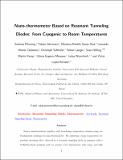Files in this item
Nanothermometer based on resonant tunneling diodes : from cryogenic to room temperatures
Item metadata
| dc.contributor.author | Pfenning, A. | |
| dc.contributor.author | Hartmann, F. | |
| dc.contributor.author | Rebello Sousa Dias, M. | |
| dc.contributor.author | Castelano, L.K. | |
| dc.contributor.author | Süßmeier, C. | |
| dc.contributor.author | Langer, F. | |
| dc.contributor.author | Höfling, S. | |
| dc.contributor.author | Kamp, M. | |
| dc.contributor.author | Marques, G.E. | |
| dc.contributor.author | Worschech, L. | |
| dc.contributor.author | Lopez-Richard, V. | |
| dc.date.accessioned | 2016-06-01T23:33:07Z | |
| dc.date.available | 2016-06-01T23:33:07Z | |
| dc.date.issued | 2015-06-23 | |
| dc.identifier | 204824903 | |
| dc.identifier | ad4b710e-3222-4117-8167-d6b0a861a49d | |
| dc.identifier | 84934934836 | |
| dc.identifier | 000356988500067 | |
| dc.identifier.citation | Pfenning , A , Hartmann , F , Rebello Sousa Dias , M , Castelano , L K , Süßmeier , C , Langer , F , Höfling , S , Kamp , M , Marques , G E , Worschech , L & Lopez-Richard , V 2015 , ' Nanothermometer based on resonant tunneling diodes : from cryogenic to room temperatures ' , ACS Nano , vol. 9 , no. 6 , pp. 6271-6277 . https://doi.org/10.1021/acsnano.5b01831 | en |
| dc.identifier.issn | 1936-0851 | |
| dc.identifier.uri | https://hdl.handle.net/10023/8914 | |
| dc.description | The authors are grateful for financial support by the BMBF via national project EIPHRIK (FKZ: 13N10710), the European Union (FPVII (2007-2013) under grant agreement No. 256959 NANOPOWER and No. 318287 LANDAUER), and the Brazilian Agencies FAPESP (2013/24253-5, 2012/13052-6, and 2012/51415-3), CNPq and CAPES. | en |
| dc.description.abstract | Sensor miniaturization together with broadening temperature sensing range are fundamental challenges in nanothermometry. By exploiting a large temperature-dependent screening effect observed in a resonant tunneling diode in sequence with a GaInNAs/GaAs quantum well, we present a low dimensional, wide range, and high sensitive nanothermometer. This sensor shows a large threshold voltage shift of the bistable switching of more than 4.5 V for a temperature raise from 4.5 to 295 K, with a linear voltage-temperature response of 19.2 mV K-1, and a temperature uncertainty in the millikelvin (mK) range. Also, when we monitor the electroluminescence emission spectrum, an optical read-out control of the thermometer is provided. The combination of electrical and optical read-outs together with the sensor architecture excel the device as a thermometer with the capability of noninvasive temperature sensing, high local resolution, and sensitivity. | |
| dc.format.extent | 7 | |
| dc.format.extent | 1914797 | |
| dc.language.iso | eng | |
| dc.relation.ispartof | ACS Nano | en |
| dc.subject | Resonant tunneling diode | en |
| dc.subject | Thermometer | en |
| dc.subject | QC Physics | en |
| dc.subject | NDAS | en |
| dc.subject.lcc | QC | en |
| dc.title | Nanothermometer based on resonant tunneling diodes : from cryogenic to room temperatures | en |
| dc.type | Journal article | en |
| dc.contributor.institution | University of St Andrews. School of Physics and Astronomy | en |
| dc.contributor.institution | University of St Andrews. Condensed Matter Physics | en |
| dc.identifier.doi | 10.1021/acsnano.5b01831 | |
| dc.description.status | Peer reviewed | en |
| dc.date.embargoedUntil | 2016-06-02 |
This item appears in the following Collection(s)
Items in the St Andrews Research Repository are protected by copyright, with all rights reserved, unless otherwise indicated.

